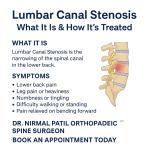Lumbar Canal Stenosis is one of the most common causes of back pain, leg pain, and difficulty walking in adults, especially after the age of 50. It develops slowly and can significantly affect mobility, comfort, and confidence. Many patients ignore the early symptoms and seek treatment only when walking becomes difficult. But with early diagnosis and proper management, most people experience excellent relief and improved quality of life.
This comprehensive guide explains what Lumbar Canal Stenosis is, why it occurs, symptoms to watch for, treatment options, and when to consult a spine specialist.
What Is Lumbar Canal Stenosis?
The lumbar spine is the lower part of the backbone. Inside the spine lies the spinal canal — a tunnel-like space that carries the spinal nerves. Lumbar Canal Stenosis means this space becomes narrow. When the canal narrows, it compresses the nerves passing through it, causing pain, numbness, tingling, or weakness in the lower body.
This narrowing usually happens gradually over years. It is a degenerative condition linked to age-related wear and tear, but it can also occur due to disc bulges, ligament thickening, or bone changes.
Think of it as a highway that slowly becomes narrower. As space reduces, traffic slows. Similarly, when the spinal canal becomes narrow, nerve signals are obstructed, resulting in discomfort and mobility problems.
Why Does Lumbar Canal Stenosis Occur?
Several changes in the spine can cause the canal to narrow. These may occur individually or together:
1. Age-Related Degeneration
As people age, spinal discs lose water content and become thinner. Bones grow irregularly forming spurs, and ligaments become thick. All these changes reduce the space around the nerves.
2. Herniated or Bulging Disc
A slipped disc can protrude backward into the canal, compressing nerve roots.
3. Thickened Ligaments
The ligament called the ligamentum flavum can become stiff and thick over time, contributing to narrowing.
4. Arthritis & Bone Spurs
Osteoarthritis can cause bone overgrowth (spurs) that compress the spinal nerves.
5. Congenital Narrow Canal
Some people are born with a naturally narrow spinal canal, making them more prone to stenosis.
6. Spinal Injuries
Fractures, dislocations, or spinal surgeries may cause scar tissue or structural changes that compress nerves.
7. Spondylolisthesis
This condition occurs when one vertebra slips forward over another, reducing space for the spinal nerves.
Understanding the underlying cause helps in selecting the right treatment.
Common Symptoms of Lumbar Canal Stenosis
Symptoms depend on how much the canal has narrowed and which nerves are compressed. It usually affects both legs but can affect one side more.
Typical symptoms include:
- Low Back Pain: Often mild to moderate, sometimes radiating to hips.
- Leg Pain (Sciatica): Sharp, shooting pain traveling down the thigh or calf.
- Numbness or Tingling: Especially in legs and feet.
- Leg Weakness: Difficulty standing or walking for long periods.
- Heaviness in Legs: Patients describe it as “legs feel heavy or tired.”
- Difficulty Walking: Pain increases while standing or walking.
- Relief When Bending Forward: Known as “shopping cart sign” — bending reduces pressure on nerves and provides relief.
- Reduced Balance: In more advanced cases.
Symptoms may start mild and progress slowly over months or years. Recognizing them early is important to prevent disability.
How Is Lumbar Canal Stenosis Diagnosed?
A spine specialist or orthopaedic surgeon performs a detailed evaluation that includes:
1. Medical History
The doctor asks about your symptoms, lifestyle, past injuries, and activities that worsen or relieve pain.
2. Physical Examination
- Checking posture and walking pattern
- Assessing leg strength
- Testing reflexes and sensations
- Checking spinal flexibility
3. Imaging Tests
These help confirm the diagnosis and determine the severity.
- X-Ray: Shows bone alignment, arthritis, and bone spurs.
- MRI Scan: The most important test; shows nerve compression, disc problems, and canal narrowing.
- CT Scan: Useful for bone-related changes.
- EMG/Nerve Tests: Rarely required but helpful if nerve damage is suspected.
Early diagnosis prevents the condition from worsening and helps avoid permanent nerve injury.
Treatment Options for Lumbar Canal Stenosis
Treatment depends on severity of symptoms, nerve compression, and the patient’s overall health. Not all patients require surgery.
1. Lifestyle Modifications
- Avoid long standing or extended walking.
- Use support while walking.
- Maintain healthy body weight.
- Improve posture and ergonomics.
These changes reduce strain on the spine.
2. Medications
Doctors may prescribe:
- Pain relievers
- Anti-inflammatory medicines
- Muscle relaxants
- Neuropathic medications for nerve pain
These help control symptoms but do not reverse stenosis.
3. Physiotherapy
Physiotherapy is one of the most effective non-surgical treatments.
Physiotherapy includes:
- Back strengthening exercises
- Flexibility training
- Core stabilization
- Posture correction
- Stretching tight muscles
Consistent therapy improves mobility and reduces nerve compression.
4. Epidural Steroid Injections
For moderate pain, targeted injections reduce inflammation around nerves and provide relief for weeks to months. These are recommended after proper evaluation and imaging.
5. Minimally Invasive Spine Surgery
When symptoms become severe or non-surgical treatments fail, minimally invasive surgery may be advised. These procedures relieve pressure on the nerves with minimal tissue damage.
Options include:
- Microdecompression
- Endoscopic decompression
- Laminectomy
- Foraminotomy
Benefits:
- Small incision
- Faster recovery
- Less blood loss
- Minimal pain
- Short hospital stay
Patients typically resume routine activities much faster than with traditional open surgery.
When Should You See a Spine Specialist?
Seek medical advice if you experience:
- Pain lasting more than 2–3 weeks
- Difficulty walking more than a few minutes
- Numbness or tingling in legs
- Weakness in feet or legs
- Loss of bladder or bowel control (medical emergency)
- Pain that improves only when sitting or bending forward
Early intervention ensures quicker recovery and prevents permanent nerve damage.
Can Lumbar Canal Stenosis Be Prevented?
While ageing cannot be prevented, lifestyle changes can reduce risk:
- Maintain healthy weight
- Stay physically active
- Strengthen core and back muscles
- Avoid prolonged sitting
- Lift weights with proper posture
- Treat injuries early
Regular check-ups help monitor spine health and prevent worsening.
Conclusion
Lumbar Canal Stenosis is a progressive condition caused by narrowing of the spinal canal in the lower back. While the symptoms can be troublesome, most patients recover well with early diagnosis, proper physiotherapy, lifestyle changes, and timely medical care. Advanced cases benefit greatly from minimally invasive spine treatments.
If you’re experiencing persistent back pain, leg heaviness, or difficulty walking, consult a spine specialist for an accurate diagnosis and personalised treatment plan. Early treatment ensures faster relief and protects long-term mobility.













